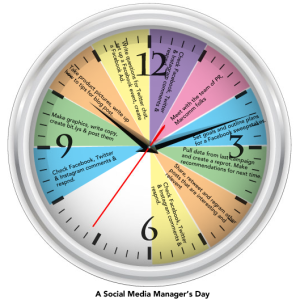Social Media Management
I have been managing brand social media accounts since 2006. It started with a corporate blog then each year a new social media platform was added to the mix. Regardless of what social media tool you are using or what your business is, there are certain best practices that remain the same. After eating, sleeping and breathing brand social media for 8 years here are my top ten tips for brand social media success that I shared them at a recent Rochester AMA meeting.
 #1 Have a plan and strategy – Start with what are your goals and who is your audience? Who does the work and how? Have best practices and crisis plans in place.
#1 Have a plan and strategy – Start with what are your goals and who is your audience? Who does the work and how? Have best practices and crisis plans in place.
This isn’t just for launching a new social media program. I revise our social media strategy every year. Your business and products change, the social media landscape changes, new tools are released… plan accordingly.
#2 Provide valuable content – Don’t just talk about yourself. Share information that is useful to your audience.
No one wants to hang with that person at the party who is always trying to sell you something. If you want your customers to connect with you on social, you have to make it worth their time.
#3 Stick with it – Post and monitor regularly and frequently (but not too frequently). Keep a calendar to plan your posts to be current and relevant.
I live by my calendar. That way I know what I am talking about online when I get into the office each day. It also keeps everyone on the same page.
#4 Integrate internally – Maintain a connection with all areas of your company. Include social media into your campaigns, projects and plans.
I have a meeting once a week with product managers, marcom, and PR so I can get updates and be sure we are all connected. Reviewing that social media calendar I maintain is part of that.
#5 Listen and respond to your audience/customers – Don’t deliver your message and walk away. Interact and answer questions. Pay attention to what they are saying.
It’s a two way conversation. Monitoring your comments and responding is as important as posting. Your social media audience is also a valuable resource. They are the world’s largest focus group. Ask them what they think. Run ideas by them.
#6 Use your fans and advocates – Connect with people who love your brand and product. Arm them with what they need to promote you. Recognize, involve & learn from them.
Make it easy for people to talk about you. As a blogger myself, it drives me nuts when I go to a brand’s website and I have to hunt for the link to their Facebook page or Twitter feed. Make sure you have links to your social media on all your assets – website, press releases, advertising. Create blogger kits with images and copy. Give bloggers special sneak peeks and use their testimonials
#7 Be real and show passion – Have a conversation, be casual, show personality & avoid corporate speak. Let your employees be brand representatives – be sure to have an employee social media policy.
Social media is not a press release. Customers find you on social media because they want a different connection. Show them that you believe in your product and let them meet the people that bring it to them each day.
#8 Use common sense – Think before you post or comment. Do your research, don’t joke about tragedy/sensitive topics, don’t be hasty, and keep your calm.
You would think I wouldn’t have to keep bringing this up, but it still happens. There are lots of case studies where someone posted something they regretted. Inappropriate personal tweets go to brand accounts, someone tries to run a BOGO based on a devastating hurricane. Also…. when dealing with trolls… always take the high road.
#9 Be transparent – Post honestly, admit when you are wrong, don’t try to control the conversation by deleting negative comments.
If you want to participate in social media you can’t dodge the issues. You have to take the bad with the good. Do not delete those negative comments. It will only come back to bite you.
#10 Measure, report and revise – Determine measures of success based on your goals, track, measure and compare. Use what you learned the next time.
This doesn’t have to be a huge spreadsheet of data. Try using bit.lys to see what is getting clicked on. Check in on your Facebook insights. You can learn a lot about what is working and what isn’t.
Armed with these best practices it would be hard to go wrong with your social media program. One more tip. To really understand social media and the tone and protocol, the best thing you can do is use it yourself. Connect with others in the social media business. Share what you learn and ask questions. Don’t let your own personal Facebook timeline or Twitter feed go neglected.
Kodak Alaris Social Media Manager
